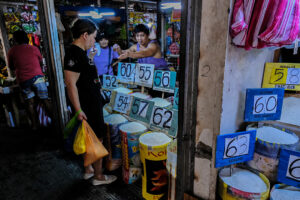BSP shuns gold amid jump in global investments

By Keisha B. Ta-asan, Reporter
PHILIPPINE gold reserves fell last year from 2013 amid an 18% jump in global gold investments, according to City Index Group.
Its gold holdings fell by 18.84% to 157.06 tons, the financial service company said in a report on Thursday, citing data from the World Gold Council.
“The Philippines is the only country in the ranking that has chosen to reduce its gold reserves, instead of shifting from passively holding gold to actively trading it,” City Index said.
“As central banks seek to use gold as an inflation hedge — a reliable measure of protection against purchasing power risk — individual consumers may consider doing the same in the form of coins or jewelry, as is particularly popular in India and China,” it added.
Gold prices surged to a near all-time high on Wednesday, with spot gold jumping to $2,072.19, just shy of a record high of $2,072.49 in 2020, Reuters reported. Safe-haven gold tends to gain during times of economic or financial uncertainty.
Rizal Commercial Banking Corp. Chief Economist Michael L. Ricafort said world gold prices have nearly doubled since 2013.
“There were sales of gold holdings a few years back to take advantage of higher world prices in recent years,” he said in a Viber message.
In 2020, the Bangko Sentral ng Pilipinas (BSP) said it would shift to active gold trading amid rising prices of gold, which is considered a safe-haven asset during crises.
“The BSP has been buying gold especially from small-scale miners and selling gold to the BSP has been encouraged in recent years,” he added.
The Philippines and Hong Kong were among the countries in the region that are not buying more gold.
China ranked the highest in the East and Southeast Asia after its gold reserves surged by 91% to 2,010.51 tons at end-2022. It was followed by Thailand (60%), Singapore (21%) and Japan (11%).
Gold reserves in China averaged 1,694.78 tons from 2013 to 2021, reaching an all-time high in the fourth quarter of last year, accounting for 3.6% of its total foreign reserves, City Index said.
“This is an increase of 90.73% from 2013, over four-fifths higher than the increase of gold reserves in Japan in the last decade, where they increased by just 10.55% from 765.22 to 845.97 tons,” it added.
Global demand for gold is typically driven by jewelry purchases, industrial use, central bank purchases and retail investment,” City Index said.
“China’s significant increase in gold holdings in the last decade is likely an attempt to diversify its foreign reserves away from the US dollar, a move that is consistent with its broader strategic goals,” Matt Weller, head of Market Research at City Index, said in a statement.
“This trend is part of a larger global shift in which countries are increasingly looking to reduce their reliance on the US dollar, and we expect this trend to continue as geopolitical tensions persist,” he added.
South Korea has chosen to increase its gold reserves by marginal amounts (0.01%), while Taiwan and Hong Kong have chosen not to add to their reserves at all.
“Both Taiwan and Hong Kong’s gold reserve levels have remained the same in the last decade,” according to the report.
Thailand has had the second-largest increase in gold reserves in the past decade, increasing by 60.2% to 244.16 tons. This is almost two-thirds more than Indonesia, where gold reserves increased by 0.64%
In Thailand, gold continues to remain popular for being an effective inflation hedge amid global economic uncertainty, City Index said
“Not only this, but the demand for gold in Thailand has risen by 40% year on year, fuelled by the rebound in tourism, according to the World Gold Council,” it added.
Singapore’s gold reserves rose by 20.68% to 153.74 tons.
Although Malaysia is considered to be the most similar country to Singapore by several metrics, its gold reserves have increased by just 6.84%, it added.
Former BSP Governor Benjamin E. Diokno had said the decision to shift to active gold trading was due mainly to the change in the price dynamics of gold at that time.
He also cited the law exempting taxes on the BSP’s bullion purchases from small-scale miners, as well as the ample dollar reserves as factors in deciding to shift to active gold trading.
A 2019 law exempted small-scale miners and traders from paying tax for gold sold to the BSP to strengthen the country’s foreign exchange buffers.
The central bank’s gold holdings were worth $10.07 billion (P558 billion) as of end-March, 7.9% higher than in February and up by 7.1% year on year.
The country’s gross international reserves inched up by 2% in March from $98.2 billion a month earlier.




